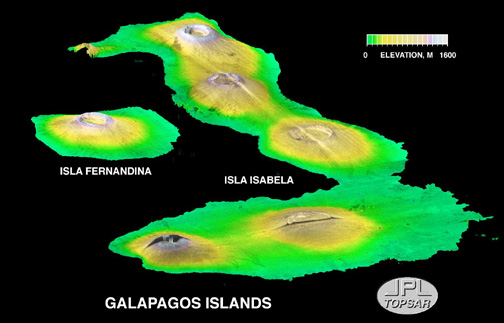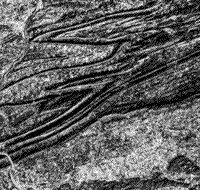

Radar Stereo; Interferometry
When flown on aircraft, a radar can point in different look directions and angles during successive passes to simulate the necessary parallax conditions for relief displacements across track. Side-looking Airborne Radar (SLAR) observations, looking out from the same side in successive passes, are best. An example showing the Appalachian Fold Belt in central Pennsylvania, using a SAR X-band system, demonstrates the quality of radar stereo.
Stereo radar images from space can produce acceptable stereo models using multiple look angle (off-nadir) viewing. Vertical and horizontal resolutions are hard to achieve by optical systems from comparable orbits. We can significantly reduce the vertical exaggeration because of low B/H values. The stereo pair below, showing volcanic terrain in Chile, acquired with the SIR-B L-band SAR from two incidence angles (54° and 45°), has moderate exaggeration of a high relief scene.
Multiple incidence angle imagery serves well in preparing perspective views, as demonstrated in this SIR-C oblique rendition of a group of volcanic calderas on two of the Galapagos Islands.

Synthetic Aperture Radar images, generated simultaneously from two antennas on the same platform, have such a small base that they do not, in themselves, function as a stereo pair. But being composed of coherent radiation, signals from each, matched to equivalent pixels in the other, show varying degrees of phase differences, indicative of partial interference. Variations in the signal travel times between two adjacent points induce the interference, and thus, show slightly different heights. When we remove Earth curvature effects and make other adjustments, residual differences become a measure of terrain elevations. SAR Interferometry is a developing technique that you can learn more about by perusing a JPL home page dealing with this subject: (http://southport.jpl.nasa.gov/scienceapps/dixon/report8.html). You can also access a relevant explanation showing how SIR-C interferometry produced topographic information for this Long Valley, CA, illustration.

The upper left panel is a Horizontal-Horizontal polarized L-band image, in which many bright-toned patches correspond to hilly rock and dark patches to smooth valley floors. Lake Crowley (dark) is at the lower left. The ridge is part of the Long Valley volcanic caldera (inactive). The upper right panel shows an interferogram derived by combining two L-band images taken in April and October, 1992, respectively. The colors relate to differences in signal phase, caused by elevation differences. In the lower left is a topographic map derived from the interferogram. Its total relief is 1,300 m (4264 ft). The lower right panel presents a 3-D perspective of this map, made by "draping" a C-band image over the L-band topographic data.
Stereo Pairs from Space
Astronauts first shot visible-IR stereo-pair photos from space during several missions. Landsat does not acquire in stereo, because its downtrack images result from continuous scanning. However, its orbital track results in 10% to 40% (near the poles) sidelap coverage along adjacent orbits (previous or next day), which provides limited area stereo viewing, if cloud conditions are favorable. This works also with images taken along contiguous orbits at various times of year. Check the stereo strips covering part of the now familiar Blue Mountain and other ridges near Harrisburg, PA: the left (or top) image was taken in October (foliage still intact), whereas that on the right (bottom) was obtained the next February (low sun angle emphasizes relief). If you succeed in getting a stereo image, note the very low vertical exaggeration (about 0.3) because of the high H value (918 km).
11-18 Is a low VE (vertical exaggeration necessarily a good thing? ANSWER


Now, try for 3-D in this Landsat false color composite stereo pairing of images of Katmandu and the surrounding Mountains in central Nepal, taken on March 20/21, 1977. The Environmental Institute of Michigan (ERIM) prepared the mount.

Primary Author: Nicholas M. Short, Sr. email: nmshort@epix.net
Collaborators: Code 935 NASA GSFC, GST, USAF Academy
Contributor Information
Last Updated: September '99
Webmaster: Bill Dickinson Jr.
Site Curator: Nannette Fekete
Please direct any comments to rstweb@gst.com.